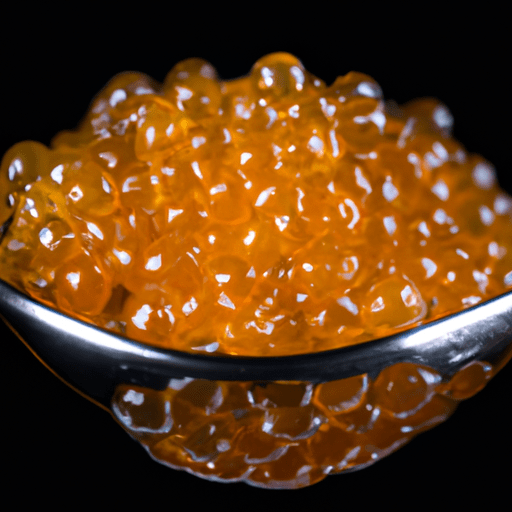Fish Roe: A Delicacy Bursting with Flavor and Nutrients
If you’re an adventurous foodie with a taste for the extraordinary, fish roe might just be a culinary gem you’ll want to explore. Also known as fish eggs or caviar, fish roe is a delicacy that has delighted palates for centuries. From its unique flavors to its impressive nutritional profile, fish roe is not only a feast for the eyes but a treat for the taste buds. In this article, we’ll dive into the enchanting world of fish roe, uncovering its taste, common culinary uses, nutritional value, and fascinating history.
The Taste of Fish Roe: A Symphony of Sensations
When it comes to taste, fish roe offers a wide range of flavors that tantalize the palate. The specific taste can vary depending on the type of fish roe you’re indulging in. From the briny pop of salmon roe to the buttery richness of sturgeon caviar, each variety offers a unique sensory experience. Fish roe can be mildly salty, savory, or even subtly sweet, making it a versatile ingredient that complements a wide array of dishes.
Common Culinary Uses: From Simple to Extravagant
Fish roe enjoys popularity in various cuisines around the world. Its delicate and distinct taste lends itself well to both simple preparations and more extravagant culinary creations. Here are some common ways fish roe is used in cooking:
- Sushi and Sashimi: Fish roe is a beloved ingredient in Japanese cuisine. Whether it’s a small garnish of tobiko on a sushi roll or a generous helping of ikura atop fresh sashimi, fish roe adds a burst of flavor and visual appeal.
- Canapés and Blinis: Miniature pancakes, known as blinis, make a perfect base for topping with crème fraîche and a dollop of fish roe. This elegant hors d’oeuvre is a classic choice for entertaining guests.
- Pasta and Risotto: A spoonful of fish roe can elevate a simple pasta or risotto dish, bringing a touch of luxury to every bite. The roe’s briny essence pairs beautifully with creamy sauces and the subtle flavors of grains or noodles.
- Sandwiches and Dip: Swapping traditional condiments like mayo or mustard with fish roe can transform an ordinary sandwich into a gourmet delight. Fish roe also makes an exceptional addition to spreads, creating a flavorsome dip for crackers or crudités.
Nutritional Value: A Powerhouse of Essential Nutrients
Besides its delightful taste, fish roe boasts an impressive nutritional profile. This delicacy is packed with essential nutrients that offer numerous health benefits. Fish roe is an excellent source of:
- Omega-3 Fatty Acids: These heart-healthy fats are renowned for their role in reducing inflammation and promoting brain health.
- Protein: Fish roe is rich in protein, making it an ideal choice for individuals seeking to increase their protein intake.
- Vitamins and Minerals: From vitamin B12 and vitamin D to iron, zinc, and selenium, fish roe contains a myriad of essential vitamins and minerals crucial for optimal health.
History and Interesting Facts
Fish roe has a fascinating history, dating back to ancient times. Here are a few noteworthy facts about this culinary wonder:
- Caviar: Caviar refers specifically to the roe of sturgeon fish. This luxurious and highly sought-after variety is synonymous with elegance and refinement.
- Cultural Significance: In many cultures, fish roe holds significant cultural and celebratory value. It is often served during festive occasions and special gatherings, signifying abundance and prosperity.
- Sustainable Harvesting: Sustainable harvesting practices have become crucial to preserve the delicate balance of fish populations and protect the future availability of fish roe.
Fish roe weaves its magic through the culinary world, enchanting food enthusiasts with its tantalizing taste and impressive nutritional qualities. Whether on sushi, blinis, or pasta, fish roe adds a touch of luxury to any dish. Its historical significance and cultural importance further elevate its allure. So, embrace your adventurous side and savor the exquisite delights of fish roe – a truly exceptional culinary indulgence.
Fish Roe
Origin and Common Uses:
- Fish roe refers to the eggs or roe of various fish species.
- It has been consumed by various cultures for centuries, and it is considered a delicacy in many cuisines around the world.
- The most commonly consumed types of fish roe include salmon, trout, sturgeon (caviar), cod, and herring roe.
- It can be eaten fresh or cured, and it is often used as a key ingredient in various dishes, such as sushi, sashimi, roe salads, canapes, and garnishes.
Nutritional Benefits:
- Fish roe is highly nutritious and provides several essential nutrients.
- It is an excellent source of protein, omega-3 fatty acids, vitamins (A, D, E, and B12), and minerals (such as iodine and selenium).
- Omega-3 fatty acids in fish roe have been associated with heart health, brain development, and reduced inflammation.
- It also contains choline, which is important for brain function and liver health, and antioxidants that may have protective effects against oxidative stress.
Unique Properties and Historical Significance:
- Caviar, the salted roe of sturgeon fish, is one of the most famous and expensive types of fish roe.
- Caviar has been considered a luxury food for centuries and has historical significance in regions such as Russia, Iran, and Azerbaijan.
- The flavor, texture, and appearance of fish roe can vary depending on the fish species and preparation method.
- Some fish roe, like the bright orange or red salmon roe (ikura), has a distinctive pop and mild, briny flavor.
- The size of fish roe can vary, ranging from tiny and delicate to large and firm, depending on the fish species.
Please note that fish roe should be consumed with caution by certain individuals, such as pregnant women, due to potential risks associated with fish toxins and high levels of vitamin A.




Use the share button below if you liked it.
It makes me smile, when I see it.